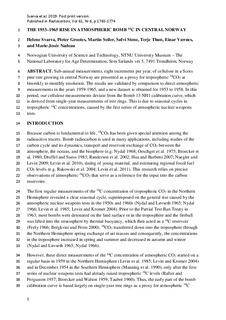| dc.contributor.author | Svarva, Helene Løvstrand | |
| dc.contributor.author | Grootes, Pieter Meiert | |
| dc.contributor.author | Seiler, Martin | |
| dc.contributor.author | Stene, Sølvi | |
| dc.contributor.author | Thun, Terje | |
| dc.contributor.author | Værnes, Einar | |
| dc.contributor.author | Nadeau, Marie-Josée | |
| dc.date.accessioned | 2020-01-21T10:22:30Z | |
| dc.date.available | 2020-01-21T10:22:30Z | |
| dc.date.created | 2019-09-09T12:59:52Z | |
| dc.date.issued | 2019 | |
| dc.identifier.issn | 0033-8222 | |
| dc.identifier.uri | http://hdl.handle.net/11250/2637192 | |
| dc.description.abstract | Sub-annual measurements, eight increments per year, of cellulose in a Scots pine tree growing in central Norway are presented as a proxy for tropospheric 14CO2 at biweekly to monthly resolution. The results are validated by comparison to direct atmospheric measurements in the years 1959–1965, and a new dataset is obtained for 1953–1958. In this period, our cellulose measurements deviate from the Bomb 13 NH1 calibration curve, which is derived from single-year measurements of tree rings. This is due to seasonal cycles in tropospheric radiocarbon (14C) concentrations, caused by the first series of atmospheric nuclear weapons tests. | nb_NO |
| dc.language.iso | eng | nb_NO |
| dc.publisher | Cambridge University Press | nb_NO |
| dc.title | The 1953-1965 rise in atmospheric bomb 14C in central Norway | nb_NO |
| dc.type | Journal article | nb_NO |
| dc.type | Peer reviewed | nb_NO |
| dc.description.version | acceptedVersion | nb_NO |
| dc.source.journal | Radiocarbon: An International Journal of Cosmogenic Isotope Research | nb_NO |
| dc.identifier.doi | 10.1017/RDC.2019.98 | |
| dc.identifier.cristin | 1722783 | |
| dc.description.localcode | Publisher embargo until June, 2020 | nb_NO |
| cristin.unitcode | 194,31,15,15 | |
| cristin.unitname | Nasjonallaboratoriene for datering | |
| cristin.ispublished | true | |
| cristin.fulltext | postprint | |
| cristin.qualitycode | 1 | |
